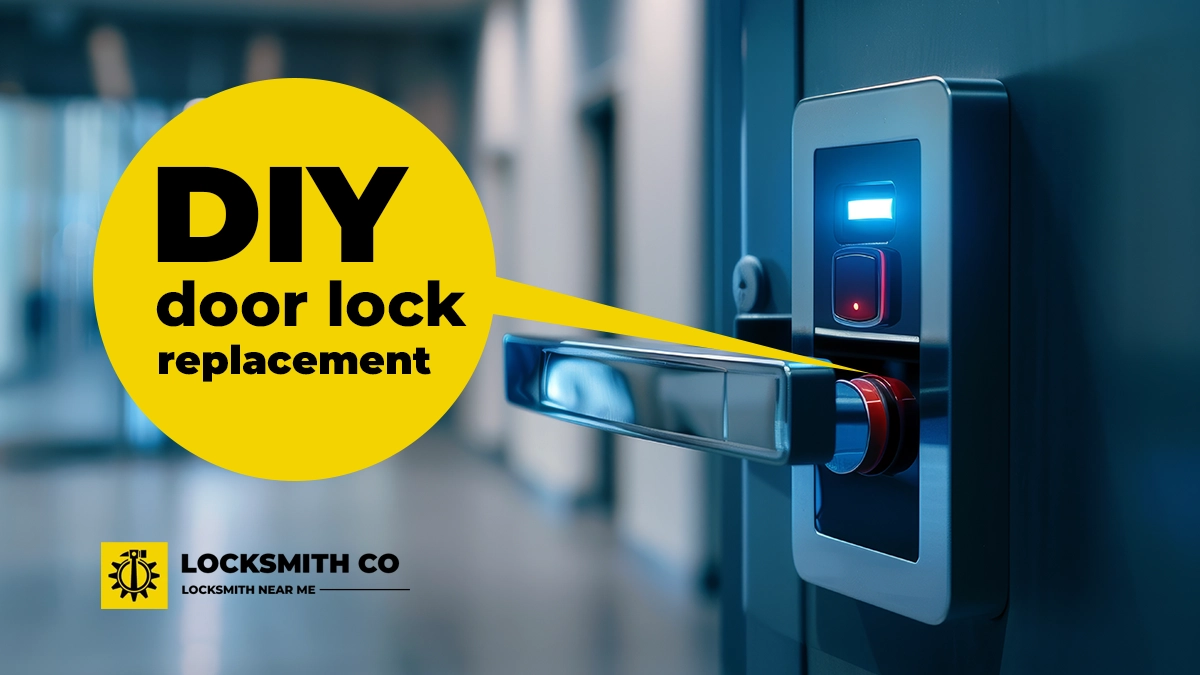Common Lock issues demystified: When to DIY and when to call a professional locksmith. From…
DIY Door Lock Replacement: A Step-by-Step Guide for Homeowners
DIY door lock replacement: A step-by-step guide for homeowners. Changing a door lock can seem like a daunting task for many homeowners, but with the right guidance, a DIY door lock replacement is entirely achievable.
Whether you’ve misplaced your keys or are simply looking to enhance your home security, knowing how to change a door lock is a vital skill.
DIY Door Lock Replacement
In this guide, we will walk you through a step-by-step process of door lock installation, providing you with essential home security tips to ensure your property remains safe and secure.
With our expert advice, you can confidently tackle this task, empowering you to take control of your home’s security while saving money on locksmith services.
Getting Started with DIY Door Lock Replacement
Tools You Need for the Job
Before you begin the process of door lock installation, it’s essential to gather all the necessary tools. Having the right equipment not only simplifies the task but also ensures a secure fit for your new lock. Here’s a list of tools you will need:
- Screwdriver: A flathead or Phillips screwdriver, depending on your lock’s screws.
- Tape Measure: To ensure precise measurements.
- Drill: Necessary for drilling new holes if required.
- Hammer: Useful for tapping components into place.
- Pliers: For gripping and twisting parts.
- Chisel: To carve out any excess wood for the lock’s fitting.
- Safety Glasses: To protect your eyes from debris.
Having these tools at hand will prepare you for a smooth and efficient DIY door lock replacement.
As we proceed, you’ll see how each tool plays a crucial role in how to change a door lock effectively.
Choosing the Right Door Lock
Selecting the correct door lock is crucial for both security and ease of installation.
There are several types of locks available, and understanding their benefits will help you make an informed decision. Here are some common options:
- Deadbolt Locks: Known for their strength, they offer excellent security for exterior doors.
- Knob Locks: Typically used for interior doors, providing basic security.
- Lever Handle Locks: Easier to operate, making them ideal for households with elderly or disabled individuals.
- Smart Locks: Offer advanced features like keyless entry and remote access, suitable for tech-savvy homeowners.
Consider factors such as the level of security needed, the ease of use, and your budget.
For exterior doors, a deadbolt is often the best choice due to its robustness.
For interior doors, knob or lever handle locks are sufficient.
By choosing the right door lock, you’ll ensure that your DIY door lock replacement not only enhances security but also meets your specific needs.
Preparing Your Door for Installation
Proper preparation of your door is a vital step in ensuring a successful door lock installation.
Start by removing the old lock. Use a screwdriver to unscrew the bolts and carefully take out the existing lock without damaging the door.
Clean the area around the hole to remove any debris or old paint that might interfere with the new lock’s fit.
Next, check the alignment of the latch and strike plate.
Ensure that they line up correctly when the door is closed. If necessary, use a chisel to adjust the area around the latch to fit the new lock snugly.
Measure the thickness of your door and the backset (distance from the edge of the door to the centre of the lock) to ensure compatibility with your new lock.
Taking these preparatory steps will facilitate a smoother DIY door lock replacement, allowing your new lock to function optimally and enhancing the overall security of your home.
Step-by-Step Guide to Changing a Door Lock
Removing the Old Door Lock
The first step in the DIY door lock replacement process is to remove the old lock.
Begin by using a screwdriver to unscrew the screws on the interior side of the door.
These screws typically hold the two halves of the lock together. Once the screws are removed, gently pull the interior and exterior lock components away from the door.
Next, focus on the latch mechanism. Unscrew the screws securing the latch plate to the edge of the door and carefully slide the latch out from the hole.
If the latch is stuck, use pliers to grip and remove it without causing damage to the door.
Inspect the door and ensure all components of the old lock are completely removed.
This step is crucial to avoid any interference when installing the new lock.
By thoroughly removing the old door lock, you set the groundwork for a smooth and hassle-free door lock installation.
Installing the New Door Lock
With the old lock removed, it’s time to install your new lock. Start by inserting the new latch into the latch hole on the edge of the door, ensuring it’s facing the correct direction for the door to close properly.
Secure it in place with screws, making sure it’s flush with the door edge for a neat fit.
Next, position the exterior lock component on the outside of the door, aligning it with the latch mechanism.
Hold it in place, then attach the interior lock component on the inside of the door.
Use the provided screws to secure both sides together, checking that the lock and keyhole are aligned.
Test the lock by turning the knob or lever and using the key to ensure smooth operation.
Adjustments may be necessary if the lock doesn’t function properly.
This step in the DIY door lock replacement ensures that your new lock is correctly installed, providing enhanced security and peace of mind.
Testing the Door Lock Installation
After completing the door lock installation, it’s crucial to test the new lock to ensure it operates smoothly and securely.
Begin by closing the door and locking it from the inside. Turn the knob or lever to confirm that the latch fully extends into the strike plate, securing the door.
Next, use the key to lock and unlock the door from the outside. Ensure that the key turns effortlessly and the latch retracts and extends without resistance. Repeat this process several times to verify consistent performance.
Additionally, check the alignment of the latch and strike plate. If the latch doesn’t align properly, you may need to adjust the strike plate position or chisel out a small amount of wood for a better fit.
By thoroughly testing the door lock installation, you can be confident that your DIY door lock replacement has been successful, providing optimal security for your home.
This final step ensures peace of mind and the reliability of your new lock.
Enhancing Home Security with DIY Projects
Home Security Tips for Beginners
Securing your home doesn’t have to be complicated or expensive.
Start by ensuring all entry points, such as doors and windows, have reliable locks. Regularly inspect and maintain them to prevent wear and tear.
Consider installing deadbolts on external doors for added protection.
Lighting is another simple yet effective security measure. Use motion-sensor lights around entrances to deter potential intruders.
These lights can automatically illuminate when movement is detected, alerting you to any unusual activity.
Additionally, be mindful of your landscaping. Trim shrubs and trees near windows and doors to eliminate potential hiding spots for intruders.
For added peace of mind, invest in a basic security camera or alarm system.
Many DIY options are available that are easy to install and monitor from your smartphone.
By following these home security tips, you can create a safer environment for you and your family, enhancing your home’s overall security without relying solely on professional services.
When to Call a Professional Locksmith
While many home security tasks can be handled independently, there are situations where it’s best to call in a professional locksmith.
If you encounter a particularly complex lock system or an installation that exceeds your skill level, seeking expert help is wise.
Professional locksmiths have the expertise to handle high-security locks, which require precise installation to maintain their integrity.
Additionally, if you’re dealing with a lockout situation or need to change door locks quickly due to a security breach, a locksmith can provide swift and reliable services.
If your door or lock is damaged from previous attempts or due to wear and tear, a professional can assess and repair it without causing further harm.
Ultimately, while DIY projects are empowering and cost-effective, recognising when to call a professional ensures that your home remains secure, saving you time and potential frustration.
Their experience and specialised tools can offer peace of mind and guarantee the job is done correctly.
Maintaining Your New Door Lock
Proper maintenance of your new door lock is essential to ensure its longevity and effectiveness.
Regularly inspect the lock for signs of wear and tear. Check the screws and components to ensure they remain tight and secure. Loose parts can compromise the lock’s functionality and security.
Lubricate the lock periodically with a graphite-based or silicone spray lubricant.
Avoid using oil-based products as they can attract dust and grime, leading to jamming. Apply the lubricant to the keyhole and moving parts for smooth operation.
Additionally, keep your keys in good condition. Bent or damaged keys can cause internal damage to the lock mechanism. If you notice any difficulty in turning the key, address the issue promptly to prevent further complications.
By maintaining your new door lock, you ensure that it continues to provide reliable security for your home.
These straightforward steps can significantly extend the life of your lock, keeping your property safe and secure.




Comments (0)